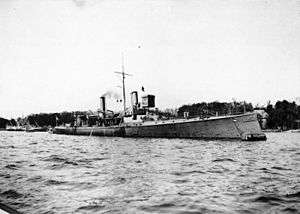SMS Comet
 | |
| History | |
|---|---|
| Name: | SMS Comet |
| Builder: | AG Vulcan |
| Laid down: | 1890 |
| Launched: | 15 January 1892 |
| Commissioned: | 29 April 1893 |
| Fate: | Scrapped, 1921 |
| General characteristics | |
| Class and type: | Meteor-class aviso |
| Displacement: | 1,117 metric tons (1,099 long tons; 1,231 short tons) |
| Length: | 79.86 m (262 ft 0 in) o/a |
| Beam: | 9.56 m (31 ft 4 in) |
| Draft: | 3.68 m (12 ft 1 in) |
| Propulsion: | 2 × 3-cylinder double expansion engines, 2 shafts |
| Speed: | 19.5 knots (36.1 km/h; 22.4 mph) |
| Range: | 960 nmi (1,780 km; 1,100 mi) at 9 kn (17 km/h; 10 mph) |
| Complement: |
|
| Armament: |
|
| Armor: |
|
SMS Comet was an aviso of the Imperial German Navy, the second and final member of the Meteor class. She had one sister ship, Meteor. Comet was laid down at the AG Vulcan shipyard in 1890, launched in January 1892, and commissioned in April 1893. Like her sister, Comet was plagued by excessive vibration and poor handling, which limited her active duty career. She ended her career as a mine hulk in Emden. After the German defeat in World War I, she was sold for scrapping in 1921.
Design
Comet was 79.86 meters (262.0 ft) long overall and had a beam of 9.58 m (31.4 ft) and a maximum draft of 3.68 m (12.1 ft) forward. She displaced 1,117 metric tons (1,099 long tons; 1,231 short tons) at full combat load. Her propulsion system consisted of two vertical 3-cylinder triple expansion engines. Steam for the engines was provided by four coal-fired locomotive boilers. The ship's propulsion system provided a top speed of 19.5 kn (36.1 km/h; 22.4 mph) and a range of approximately 960 nautical miles (1,780 km; 1,100 mi) at 9 kn (17 km/h; 10 mph). Comet had a crew of 7 officers and 108 enlisted men.[1]
As built, the ship was armed with four 8.8 cm SK L/30 guns placed in single pivot mounts, two side-by-side forward, and two side-by-side aft. The guns were supplied with between 462 and 680 rounds of ammunition. Comet also carried three 35 cm (14 in) torpedo tubes, one mounted submerged in the bow and the other two in deck-mounted launchers on the broadside. She was protected with a 15 mm (0.59 in) thick deck, along with 30 mm (1.2 in) of steel armor plating for the conning tower.[1]
Service history
Comet was built by the AG Vulcan shipyard in Stettin. She was laid down in 1890 and launched on 15 January 1892. After the completion of fitting-out work,[2] she was transferred to Kiel, where she was commissioned for sea trials.[3] Comet was commissioned into the German fleet on 29 April 1893.[2] That summer, she served in the newly formed III Division of the Maneuver Fleet for the annual maneuvers in August and September.[3]
Comet served only briefly with the fleet, owing in large part to her poor handling and excessive vibration at high speed.[2] She and her sister ship Meteor were quickly placed in reserve, though in 1899 they were reclassified as light cruisers.[4] Starting on 3 May 1904, Comet was employed as a harbor defense ship in Danzig. She was stricken from the naval register on 24 June 1911 and starting in 1913 was used as a mine hulk in Emden. She served in this capacity through World War I and was broken up in 1921 in Hamburg.[1]
Notes
References
- Cleveland, H. F., ed. (June 1894). Journal of the Royal United Service Institution. London: Harrison and Sons. XXXVIII. Missing or empty
|title=(help) - Gardiner, Robert, ed. (1979). Conway's All the World's Fighting Ships: 1860–1905. London: Conway Maritime Press. ISBN 0-85177-133-5.
- Gardiner, Robert; Gray, Randal, eds. (1984). Conway's All the World's Fighting Ships: 1906–1922. Annapolis, MD: Naval Institute Press. ISBN 978-0-87021-907-8.
- Gröner, Erich (1990). German Warships: 1815–1945. Annapolis, MD: Naval Institute Press. ISBN 0-87021-790-9.